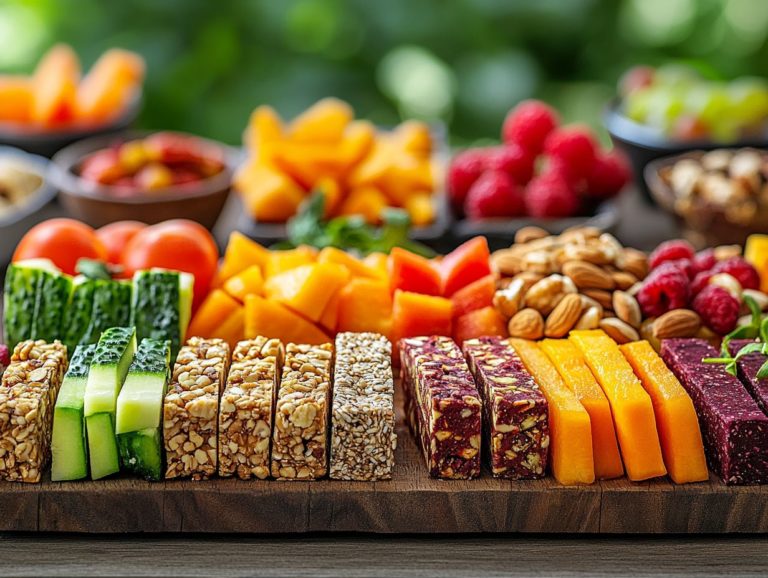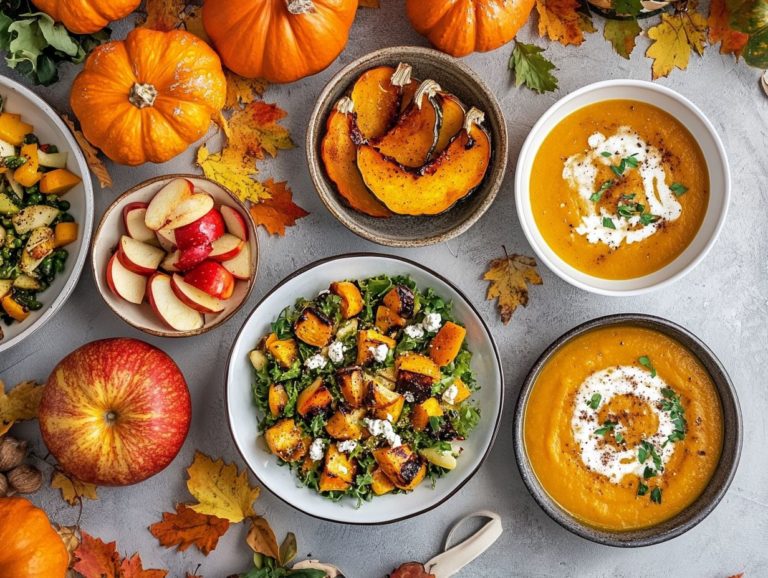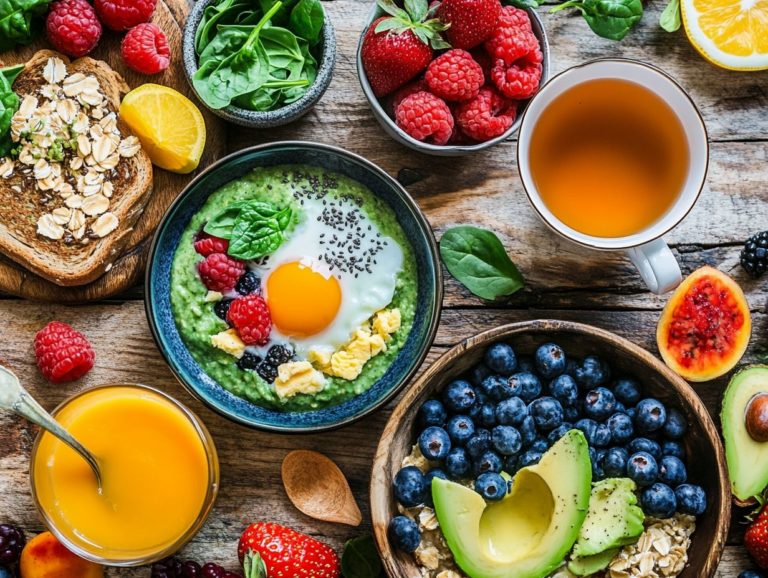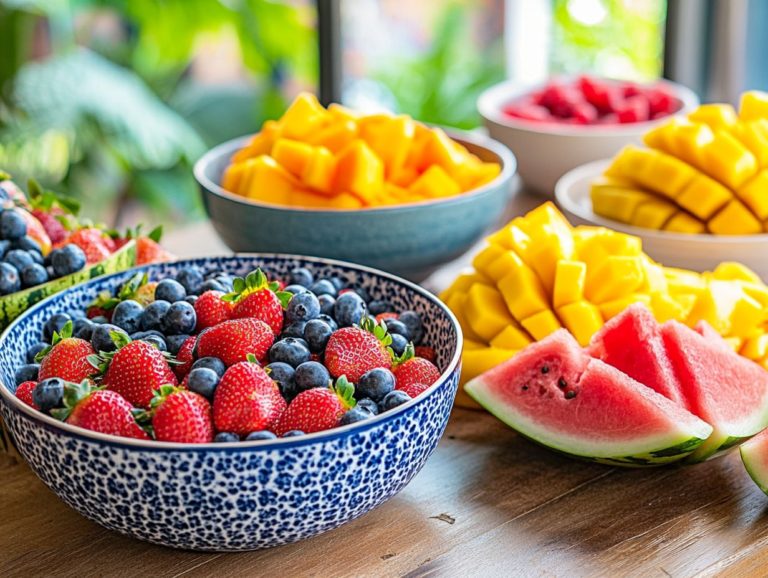Tasty Gluten-Free Recipes for Every Occasion
Eating gluten-free doesn t mean you have to give up on flavor or variety.
Whether you re in search of delightful breakfast ideas, filling lunch options, or indulgent desserts, this article is here to meet your needs.
Dive into dishes suitable for every occasion, from quick snacks to sophisticated appetizers and cozy one-pot meals.
You will find tips for adapting your favorite recipes, grasping the gluten-free lifestyle, and ensuring your meals are genuinely gluten-free.
Discover just how easy and delicious gluten-free cooking can be!
Contents
- Key Takeaways:
- 1. Breakfast Ideas
- 2. Lunch Options
- 3. Dinner Delights
- 4. Snack Time Treats
- 5. Decadent Desserts
- 6. Appetizers and Finger Foods
- 7. Comfort Foods
- 8. One-Pot Meals
- 9. International Flavors
- 10. Healthy Choices
- 11. Quick and Easy Recipes
- 12. Crowd-Pleasing Dishes
- 13. Vegetarian and Vegan Options
- 14. Gluten-Free Baking
- 15. Special Occasion Meals
- What Is a Gluten-Free Diet and Why Is It Important?
- Frequently Asked Questions
- What are some tips for finding tasty gluten-free recipes for every occasion?
- What ingredients should you avoid in gluten-free recipes?
- What substitutes can you use for gluten ingredients?
- What are some gluten-free recipes for special occasions?
- Can gluten-free recipes still be tasty?
- Should I follow a strict gluten-free diet if I don’t have Celiac disease?
Key Takeaways:
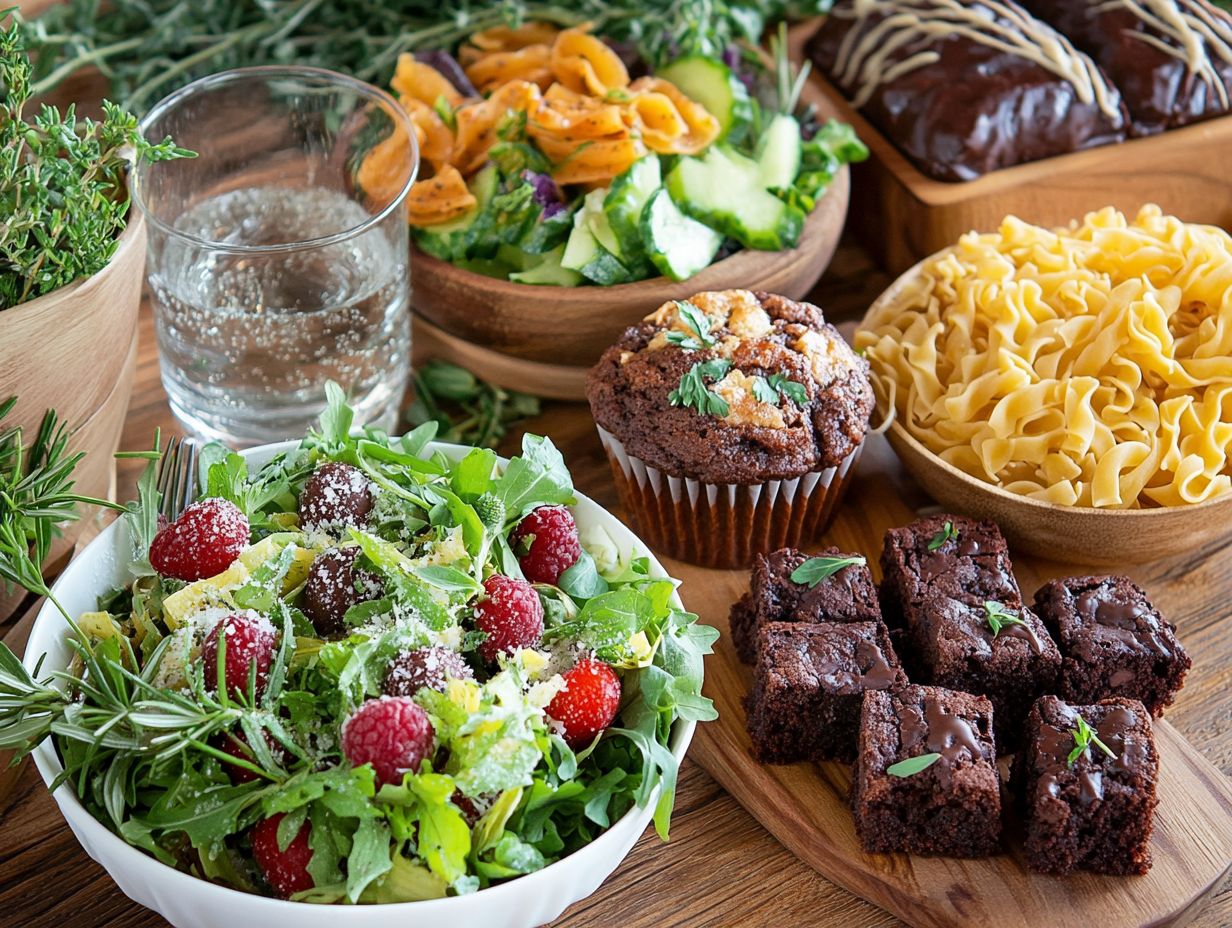
- Switching to a gluten-free diet can be enjoyable and delicious with these easy and tasty recipes for every meal.
- From international flavors to comfort foods, these gluten-free options cater to every palate and dietary need.
- Ensure a truly gluten-free meal by being aware of common ingredients to avoid and making modifications to your favorite recipes.
1. Breakfast Ideas
Breakfast is often celebrated as the most important meal of the day. If you’re following a gluten-free diet, discovering delicious and creative meal ideas can elevate both your energy and health.
Picture overnight oats adorned with fresh berries or savory frittatas crafted with Swiss chard and avocado slices. Gluten-free breakfasts can be just as satisfying as they are nourishing.
By making thoughtful choices around gluten-free ingredients, you can enjoy this essential meal without concern, whether you have food allergies or celiac disease.
Consider whipping up gluten-free pancakes made from almond flour, drizzled with pure maple syrup for that perfect touch of sweetness. Or think about smoother bowls blended with spinach and banana, topped with gluten-free granola for a delightful medley of flavors and nutrients.
If you’re in the mood for something heartier, whisk together eggs with vibrant vegetables like bell peppers and zucchini for a truly savory frittata.
When preparing breakfast, it s wise to include healthy fats, such as nut butters or coconut oil, to help maintain stable energy levels. By experimenting with these ingredient combinations, you can explore a rich array of tastes while adhering to gluten-free guidelines.
2. Lunch Options
Lunch options for those following a gluten-free diet can be both satisfying and diverse. You can enjoy everything from hearty chicken salads to refreshing mixes filled with fresh greens and cherry tomatoes.
Imagine a protein-packed chicken salad enhanced with crunchy nuts, seeds, and a zesty vinaigrette that elevates every bite.
Gluten-free pasta serves as a fantastic base for a variety of dishes. When tossed with seasonal vegetables and a light sauce, you create a wholesome lunch experience that s hard to resist.
To further enhance your gluten-free cooking endeavors, local community resources and workshops can provide invaluable tips and tricks, guiding you to discover new recipes while building connections within your community.
3. Dinner Delights
Dinner offers a chance to dive into delicious gluten-free meals. Indulge in everything from crispy chicken tenders coated in gluten-free breading to rich, flavorful tomato sauce draped over gluten-free pasta.
These incredible dishes will turn your weeknight meals into something special. Take those crispy chicken tenders, for example; they not only satisfy your cravings for comfort food but can also be paired with a side of roasted vegetables or a vibrant fresh salad to boost the meal’s nutritional profile.
Regarding sauce, why not whip up a homemade tomato sauce? Simply simmer ripe tomatoes with garlic and herbs to create an aromatic base that elevates any pasta dish to new heights.
If you’re feeling a touch adventurous, using gluten-free flour blends special mixes that do not contain gluten can help you achieve the perfect texture in batter or breading, ensuring that everyone at the table enjoys a delicious and wholesome dinner.
4. Snack Time Treats
Snack time is the perfect chance to treat yourself with gluten-free treats that taste great and cater to various dietary needs.
Get creative and make a variety of gluten-free snacks to satisfy your cravings while promoting a healthy lifestyle. Imagine homemade popcorn seasoned with nutritional yeast (a cheese-flavored seasoning) or a mix of nuts and dried fruits for a delicious trail mix.
Enjoy crunchy vegetables with homemade hummus made from chickpeas, tahini (a sesame paste), and lemon juice a nutrient-rich option you ll love! Always check that your ingredients are certified gluten-free, as hidden sources can lurk in pre-packaged items.
By making these easy snacks, you indulge your taste buds and feel good about your choices!
5. Decadent Desserts
Indulging in decadent desserts while following a gluten-free diet is absolutely within your reach. Imagine savoring options like rich flourless chocolate cake or a delicious apple pie that can easily satisfy your sweet cravings.
Whether you re entertaining guests or treating yourself, the range of gluten-free dessert recipes available today means there s something delightful for everyone. Think about luscious, fudgy cakes made without traditional flour or a classic apple pie with a buttery, gluten-free crust the possibilities truly are endless!
Using natural sweeteners like maple syrup not only elevates the flavor but provides a wholesome alternative to refined sugars.
The growing community for gluten-free baking offers extensive resources and tips to refine your creations, all while fostering a supportive environment that encourages sharing and collaboration among fellow enthusiasts.
6. Appetizers and Finger Foods
Gluten-free appetizers and finger foods can instantly transform your gatherings! These delightful options not only ensure every guest feels included, but they also create an inviting atmosphere, rich with tantalizing aromas and vibrant colors.
Picture a beautifully arranged spread of bite-sized delights, from savory stuffed mushrooms to crispy zucchini fritters, each complemented by tangy dipping sauces that elevate their flavors. Your guests will rave about these tasty bites!
By enhancing these dishes with fresh herbs like basil, cilantro, or chives, you introduce a burst of freshness and aroma that will truly delight the palate. Consider setting up a DIY appetizer station where guests can customize their bites with a variety of sauces and toppings this interactive touch encourages conversation and makes the gathering even more enjoyable.
7. Comfort Foods
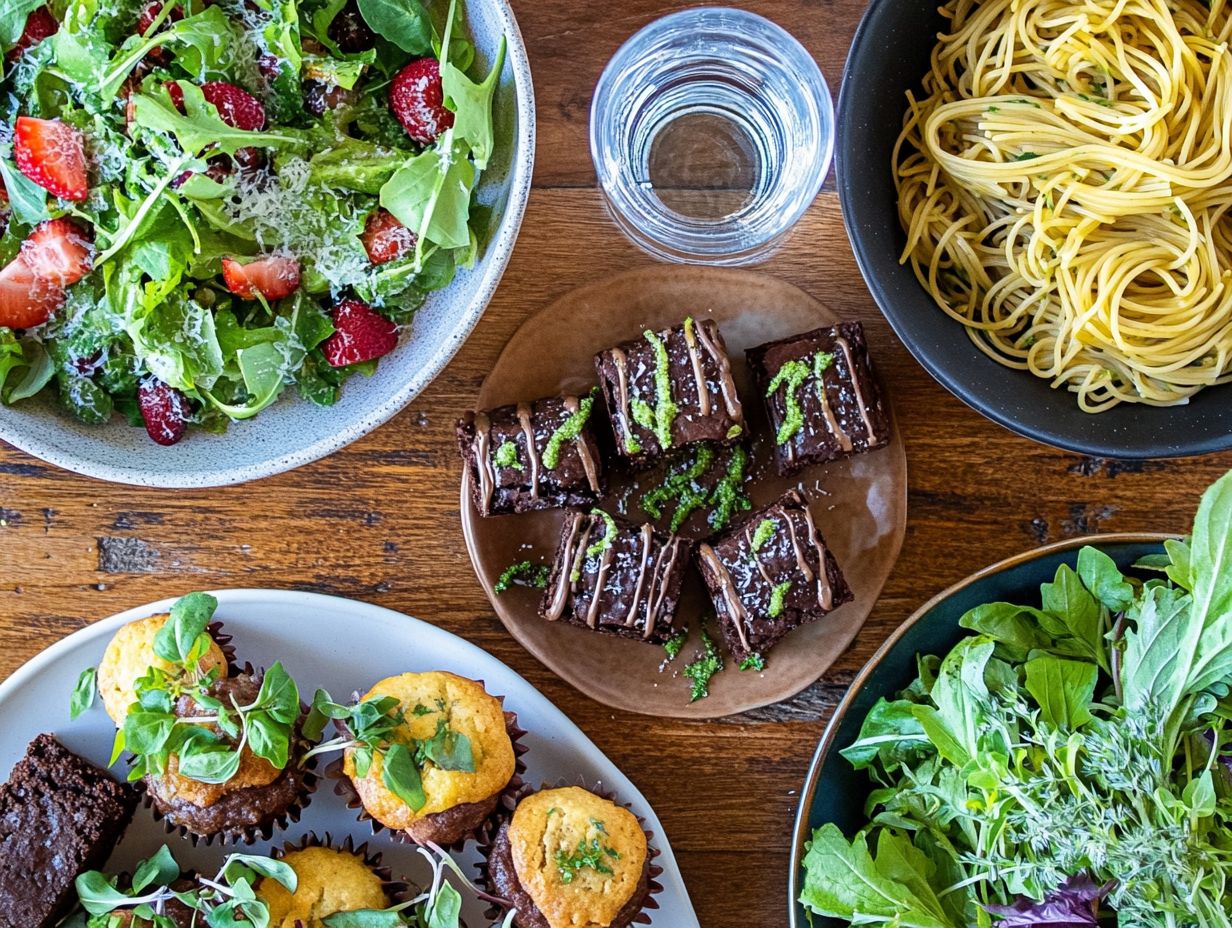
Comfort foods evoke a sense of warmth and satisfaction, and gluten-free versions can provide all the nostalgic flavors you crave without compromising your dietary needs.
These dishes often bring back cherished memories, making them a perfect choice for indulging without the gluten. Take crispy chicken tenders, for example coated in gluten-free breading, they offer a delightful crunch that makes them an ideal snack or meal option.
Then there s coconut chicken, infused with a hint of tropical sweetness, transporting you to sunnier days and serving as a delightful alternative to traditional comfort foods.
Both options nourish not just the body but also the soul, reminding you of shared meals and family gatherings, creating a sense of belonging and comfort in every bite.
8. One-Pot Meals
One-pot meals are a game-changer! They offer both convenience and the ability to whip up delicious gluten-free dishes that are perfect for hectic weeknight dinners.
These versatile recipes can truly be lifesavers for anyone balancing work, family, and social commitments. With only a single pot in play, cleanup is a breeze, giving you more time to savor meals with loved ones.
Imagine indulging in savory quinoa stir-fries, hearty lentil soups, or vibrant vegetable curries all effortlessly created in one pot! Sharing these simple meal ideas cultivates a sense of community, inspiring friends and family to swap recipes and collaborate on meal prep.
This communal approach not only enhances your culinary skills but also weaves unforgettable memories around the dinner table.
9. International Flavors
Exploring international flavors in gluten-free cooking opens up a world of possibilities, allowing you to delve into a diverse range of recipes that accommodate various dietary needs, including food allergies.
Incorporating gluten-free pasta into your dishes lets you create mouthwatering meals that celebrate global cuisines. Picture yourself savoring a zesty Thai stir-fry with rice noodles or relishing an Italian classic, reimagined with lentil or chickpea pasta.
The beauty of this journey lies in the chance to experiment with spices and ingredients unique to different cultures, like smoky paprika from Spain or fragrant basil from Italy.
From tangy sauces to vibrant vegetable medleys, using gluten-free pasta provides a seamless way to embrace culinary creativity while ensuring your meals are safe for those with gluten sensitivity a reaction to gluten found in wheat and related grains.
10. Healthy Choices
Making healthy choices on a gluten-free diet is not only possible but can also be a delightful journey! By focusing on fresh greens and wholesome ingredients, you can enhance your overall well-being.
Incorporating a variety of colorful vegetables, lean proteins (like chicken, turkey, or fish), and whole grains into your meal planning allows you to create balanced, nourishing dishes that satisfy your cravings without compromising health. Fresh greens like spinach and kale add a vibrant touch to your plate while delivering essential vitamins and minerals that strengthen your immune system.
Utilizing resources such as local support groups and online forums offers invaluable guidance as you navigate gluten-free living. Engaging in workshops or cooking classes that focus on gluten-free recipes further enables you to make informed dietary choices and connect with like-minded individuals.
11. Quick and Easy Recipes
Quick and easy recipes are a true lifesaver for anyone navigating a gluten-free diet! They provide meal ideas that can be prepared in a flash while still being nutritious and bursting with flavor.
For those with busy schedules, having a collection of straightforward gluten-free options can transform your meal planning. Imagine vibrant vegetable stir-fries or effortless quinoa salads that come together in under 30 minutes. By utilizing kitchen staples like pre-washed greens and canned beans, you save precious prep time while ensuring your meals remain satisfying. Adding your favorite proteins, such as grilled chicken or tofu, introduces versatility without complicating the cooking process.
By keeping a well-stocked pantry filled with gluten-free grains and spices, you can easily whip up dishes that meet dietary needs and tantalize your taste buds.
12. Crowd-Pleasing Dishes
Creating crowd-pleasing dishes for a gluten-free audience is not just enjoyable it s incredibly rewarding! It brings people together over satisfying meals everyone can savor.
Embrace a diverse array of ingredients and innovative cooking techniques. Impress your guests with flavorful options that don t skimp on taste. Explore a variety of cuisines think vibrant Mediterranean salads or hearty gluten-free pastas ensuring there’s something delightful for everyone at the table.
Don t underestimate the importance of presentation; envision colorful platters and creative garnishes that elevate the entire dining experience. Engaging with the community, whether through local gluten-free groups or social media platforms, offers valuable insights and makes it easier to discover new recipes. Share your culinary triumphs with others equally passionate about gluten-free cooking!
Start experimenting with these flavors today!
13. Vegetarian and Vegan Options
Vegetarian and vegan options can seamlessly adapt to fit a gluten-free diet, offering a delightful array of flavorful meals that are both satisfying and nourishing.
Incorporating a vibrant mix of fresh herbs can elevate the taste of your dishes while delivering essential nutrients. By utilizing protein-rich ingredients like legumes, quinoa, or chickpeas, you create a robust foundation for your meals, ensuring your energy levels remain high.
It s vital to scrutinize gluten-free labels, especially in meat substitutes like tempeh or seitan, which may harbor hidden gluten.
Exploring recipes that blend colorful vegetables with aromatic spices will not only tantalize your taste buds but also provide a well-rounded dietary experience. This approach invites creativity into your kitchen, making it easier to maintain a balanced and enjoyable meal plan.
14. Gluten-Free Baking
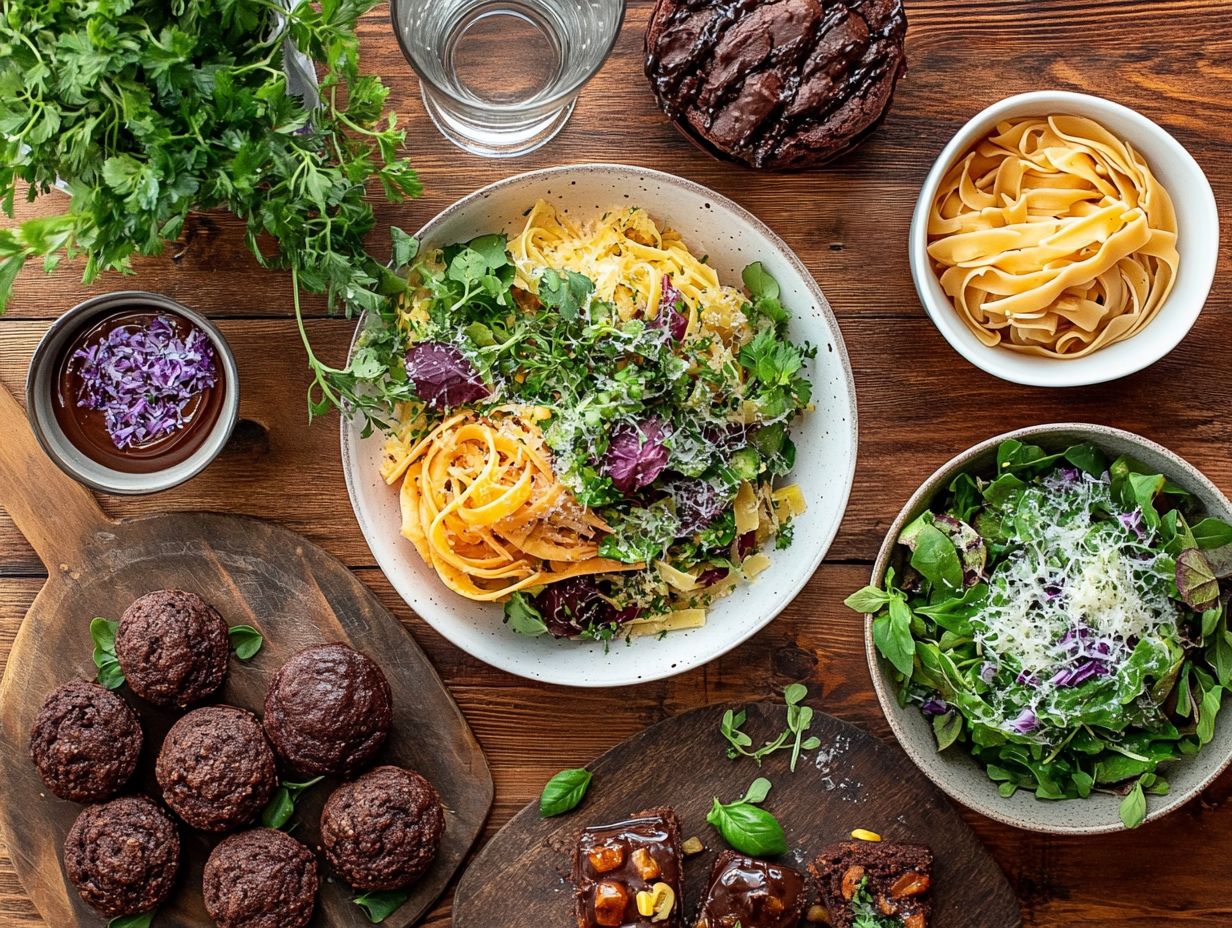
Gluten-free baking opens up an exciting world of possibilities. You can explore creative recipes that satisfy your sweet cravings while staying true to your dietary restrictions.
With a diverse array of gluten-free flour options think almond, coconut, and rice flour you can effortlessly adapt your favorite recipes. It’s essential to understand how these flours behave differently from traditional wheat flour; for example, almond flour brings moisture and richness, whereas coconut flour tends to absorb more liquid.
One delectable recipe to consider is a flourless chocolate cake, which uses eggs for structure and achieves a rich, fudgy texture without any gluten in sight. You can find invaluable resources in communities and online forums where you can get tips, troubleshoot issues, and share your favorite recipes.
15. Special Occasion Meals
Celebrating special occasions with gluten-free meals can be a feast for the senses, ensuring every guest feels included and catered to with satisfying dishes.
By incorporating a variety of recipes, you can craft an impressive menu that caters to diverse tastes and dietary needs. Imagine a beautifully roasted chicken, marinated with fresh herbs, serving as a stunning centerpiece. Pair it with a vibrant quinoa salad brimming with seasonal vegetables, adding both color and nutrition to the table.
Desserts can truly steal the show with options like flourless chocolate cake or almond macarons. The role of community support in sharing recipes is invaluable; friends and family can contribute their favorite gluten-free creations, fostering a sense of unity and creativity that elevates the entire celebration.
What Is a Gluten-Free Diet and Why Is It Important?
A gluten-free diet is essential for you if you have celiac disease or non-celiac gluten sensitivity. Consuming gluten can lead to severe health issues and worsen food allergies, so being aware of hidden sources is crucial.
Gluten is a protein found in certain grains like wheat, barley, and rye that can trigger inflammation and damage your digestive system. Eliminating gluten from your diet can significantly enhance your overall health and quality of life.
Look beyond obvious culprits like bread and pasta; gluten can also be lurking in sauces, dressings, and certain processed foods. Developing a keen eye for labels and understanding cross-contamination when gluten accidentally mixes with gluten-free foods are critical steps in maintaining your health.
By cultivating a lifestyle that prioritizes gluten-free options, you can avoid unnecessary discomfort and enjoy a fuller, more vibrant life.
How Can One Modify Their Favorite Recipes to Be Gluten-Free?
Modifying your favorite recipes to be gluten-free can be a truly rewarding journey, allowing you to enjoy cherished dishes while prioritizing your health and dietary needs.
By exploring various ingredient substitutions, like swapping traditional wheat flour for almond or coconut flour, you can maintain the intended texture and flavor of your beloved meals. Regarding binding agents, consider using flaxseed meal or chia seeds as effective alternatives to achieve that satisfying consistency.
You’ll also want to adjust your cooking techniques. For instance, baking times may vary slightly when using gluten-free flours. Keeping a vigilant eye on your dish is essential.
Get creative and experiment! You can turn your favorite dishes into gluten-free delights that everyone will love.
What Are the Benefits of a Gluten-Free Diet?
The advantages of a gluten-free diet go beyond simply avoiding discomfort for those with celiac disease or non-celiac gluten sensitivity. This approach can genuinely enhance overall health and well-being by minimizing food allergies.
By adopting this dietary choice, you can experience improved digestion and better nutritional absorption. You may also notice a boost in energy levels.
Many individuals find relief from bloating, gas, and other gastrointestinal issues, transforming their daily experiences into something far more comfortable. Embracing a gluten-free lifestyle often inspires a journey into the world of whole, unprocessed foods, fostering a more balanced nutrient intake.
These positive changes do more than just alleviate physical symptoms; they can also sharpen mental clarity and bolster emotional stability. This significantly elevates the quality of life for those navigating gluten-related disorders.
What Are Some Common Ingredients to Avoid in Gluten-Free Cooking?
In gluten-free cooking, it s vital to be mindful of common ingredients that contain gluten, along with hidden sources that could disrupt your dietary restrictions.
While staple items like wheat, barley, and rye are the obvious foods that contain gluten, you should also keep an eye out for less recognizable sources lurking in processed foods, such as malt extract and certain stabilizers.
Sauces and dressings can be particularly tricky, often concealing these ingredients under names that might not ring a bell. When shopping, diligence in reading labels is essential, as gluten can sneak into unexpected places like soups, gravies, and even some brands of soy sauce.
Whenever possible, opt for certified gluten-free products. If you re dining out, don t hesitate to ask about food preparation practices. Staying vigilant is your best ally in maintaining a gluten-free lifestyle.
How Can One Make Sure Their Meals Are Truly Gluten-Free?
Ensuring your meals are genuinely gluten-free demands a keen eye in the kitchen and an awareness of potential hidden sources of gluten that might easily slip under the radar.
To cultivate a safe gluten-free kitchen environment, it s essential to carve out designated areas specifically for gluten-free food preparation and storage. This means utilizing separate cutting boards, utensils, and even appliances to significantly reduce the risk of cross-contamination (the unintentional transfer of gluten from gluten-containing foods to gluten-free foods).
A thorough examination of food labels becomes critical, as gluten can lurk in unexpected places, such as sauces or pre-packaged seasonings. Sourcing your ingredients from trusted suppliers who clearly label their products as gluten-free safeguards your cooking process and instills greater confidence when preparing meals for those with gluten sensitivities.
Check out this video for more tips on gluten-free cooking!
Frequently Asked Questions
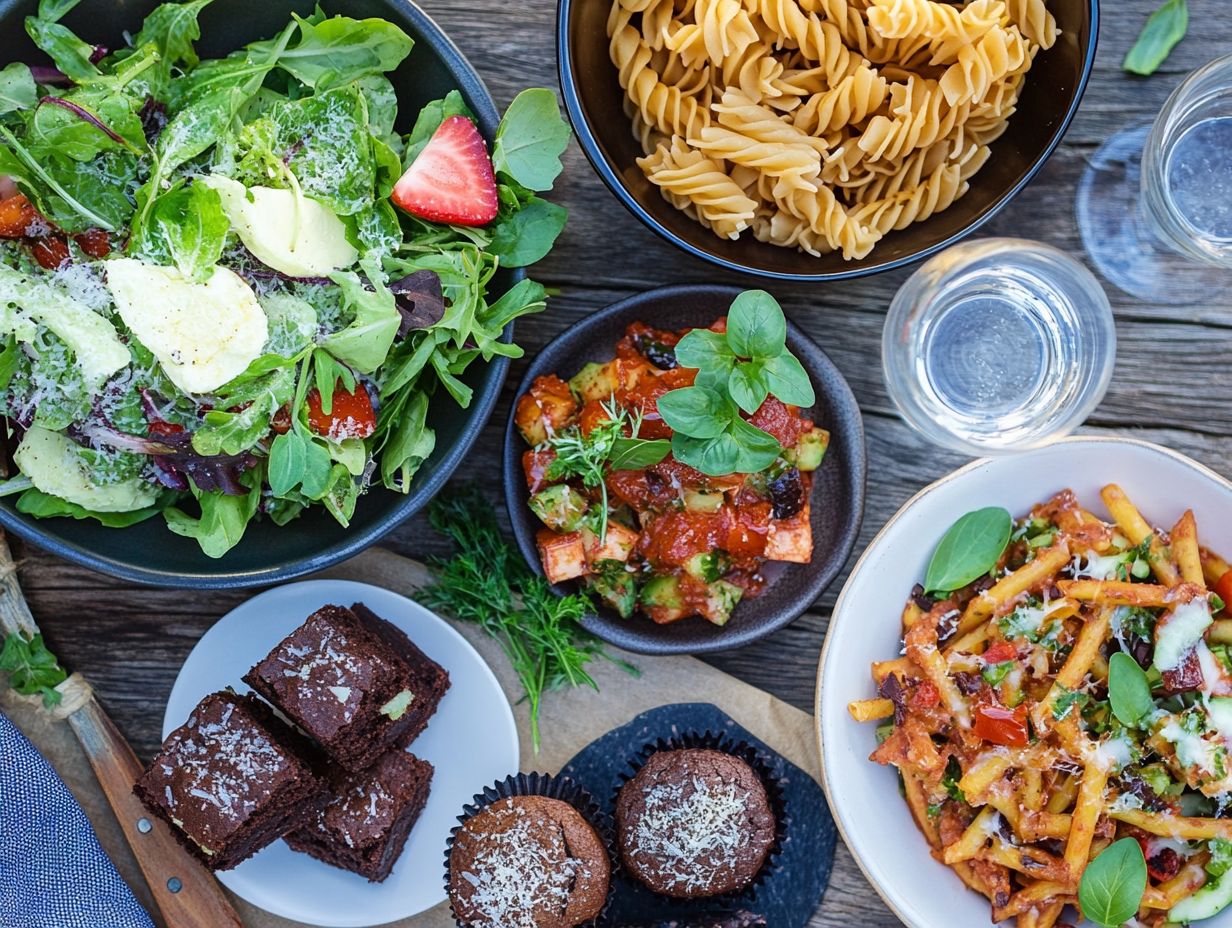
What are some tips for finding tasty gluten-free recipes for every occasion?
Some tips for finding tasty gluten-free recipes include using online resources, looking for cookbooks specifically focused on gluten-free cooking, and asking for recommendations from friends or support groups.
Start your gluten-free adventure today and enjoy the benefits of delicious, healthy meals!
What ingredients should you avoid in gluten-free recipes?
Avoid wheat, barley, rye, and oats unless they are labeled gluten-free.
What substitutes can you use for gluten ingredients?
Try gluten-free flours like almond or coconut flour. You can also use gluten-free breadcrumbs and thickeners like cornstarch or arrowroot powder.
What are some gluten-free recipes for special occasions?
Delicious gluten-free cakes and pies are perfect for celebrations.
Think about adding gluten-free stuffing or gravy to your holiday meals!
Can gluten-free recipes still be tasty?
Yes! You can make gluten-free recipes just as flavorful and satisfying with the right ingredients and cooking techniques.
Should I follow a strict gluten-free diet if I don’t have Celiac disease?
You don t have to be strict with gluten if you re not Celiac. Many people feel better by reducing gluten, but always check with a healthcare professional before making big dietary changes.


